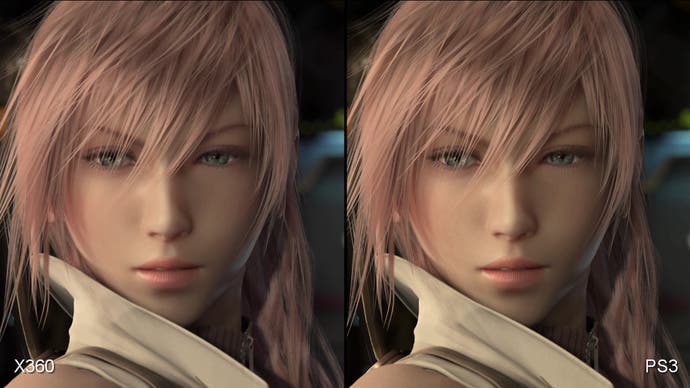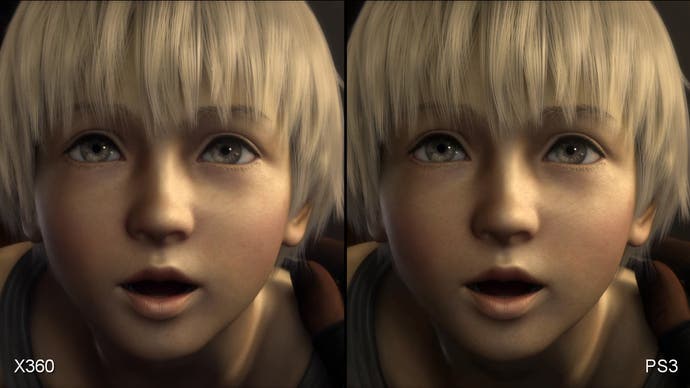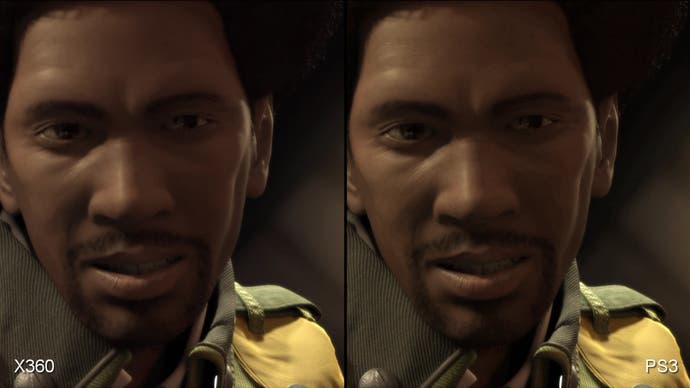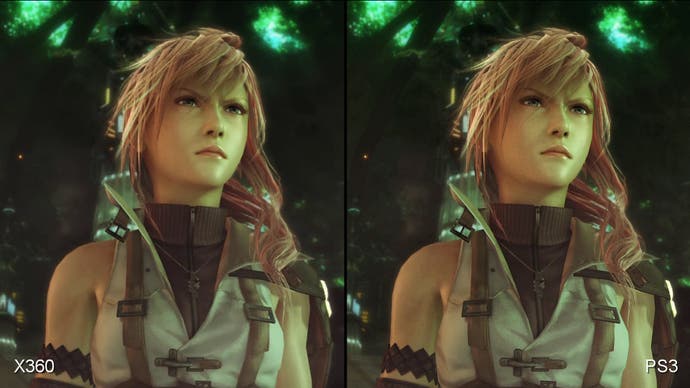Face-Off: Final Fantasy XIII
The neverending story.
The thing is, running in that single tile of eDRAM, Square-Enix has almost limitless bandwidth and enormous levels of fill-rate at its disposal. So it is extremely disappointing to note that the alpha-to-coverage interlace-style effect on the characters' hair remains in the Xbox 360 game.
Introduced on PS3 presumably in order to address the bandwidth deficiency of the RSX, the fact that it has been retained on Xbox 360 in a scenario where this effect should have been easily replaced with a more conventional alpha test technique for handling transparencies is frankly puzzling.
More than that, as the alpha-to-coverage effect is now rendered at sub-HD resolutions, the process of resizing it to 720p makes it look a whole lot worse. This is where the initial "grainy" reports of the 360 build probably originated from. Below is a closer look at the phenomenon in effect.
Note that while the characters' hair is the most obvious effect of the alpha-to-coverage, you can see that it is also deployed where transparency is required in some of the backgrounds. Here the sub-HD effect blends away some of the problem, but causes an unattractive, shifting shimmering as a consequence.
To get a closer look at the effect without the need for video, here are a couple of choice shots showing the extent of the impact to overall image quality on both platforms.


Despite notable improvements over the initial demo code, Final Fantasy XIII on PlayStation 3 still had a few performance weaknesses in its final Japanese retail rendition and these have been carried over to the UK launch code too. The Crystal Tools engine seems to have issues rendering several characters simultaneously, especially if the protagonists are close-up when presumably the highest LOD models are being displayed. Additionally, the full-resolution alpha buffers used for the likes of particle effects could also cause issues - pretty impactful in the demo code, much improved in the retail release.
We previously speculated that this would be less of an issue on the Xbox 360 and it turns out we were right. But of course, bearing in mind the big resolution reduction, if there wasn't some kind of performance benefit, we'd be pretty shocked.
To illustrate the improvements Xbox 360 brings to the table such as they are, here's a selection of clips put through frame-rate analysis. You'll see that while both versions can drop frames, it is the Xbox 360 version that is undoubtedly smoother on average. Minimum frame-rate is 26FPS on 360, and 20FPS on PS3. It's interesting to note that the character close-ups are seemingly no problem for the 360: 30FPS is maintained while PS3 struggles.
So, with the actual gameplay addressed, let's get the thorny issue of the video sequences out of the way. Personally I'm a firm advocate of playing games rather than watching them, and in this respect Final Fantasy's method of divorcing narrative from gameplay leaves me cold. But clearly they're a core part of what Final Fantasy is and what the colossal fanbase expects from the game, and bearing in mind how intrinsically linked this element of the package is to the storage space issue, it's an important part of the analysis.
The sad truth is that Square Enix's solution for transitioning the 32GB of CG video to DVD is unfortunately rather poor. A "one size fits all" encoding technique appears to have been used to compress the assets. Now, assuming the company also did this for PS3, this strategy can work fairly well: throw enough bandwidth at any image and the picture quality will hold up. Bearing in mind that FFXIII occupies more space for its videos than many commercial Blu-ray movies, this is perhaps not surprising.
What about 360 then? Comparing the two versions running in 720p mode, we see that sometimes the reduced bandwidth encoding manages to perform fairly well in comparison:




In these shots, typically the colour range is fairly static or muted, and the talking heads style of presentation is made for efficient video encoding: there's plenty of re-usable image data from one frame that can be carried over to the next. The quality of the image - while still clearly reduced - can look fairly decent.








